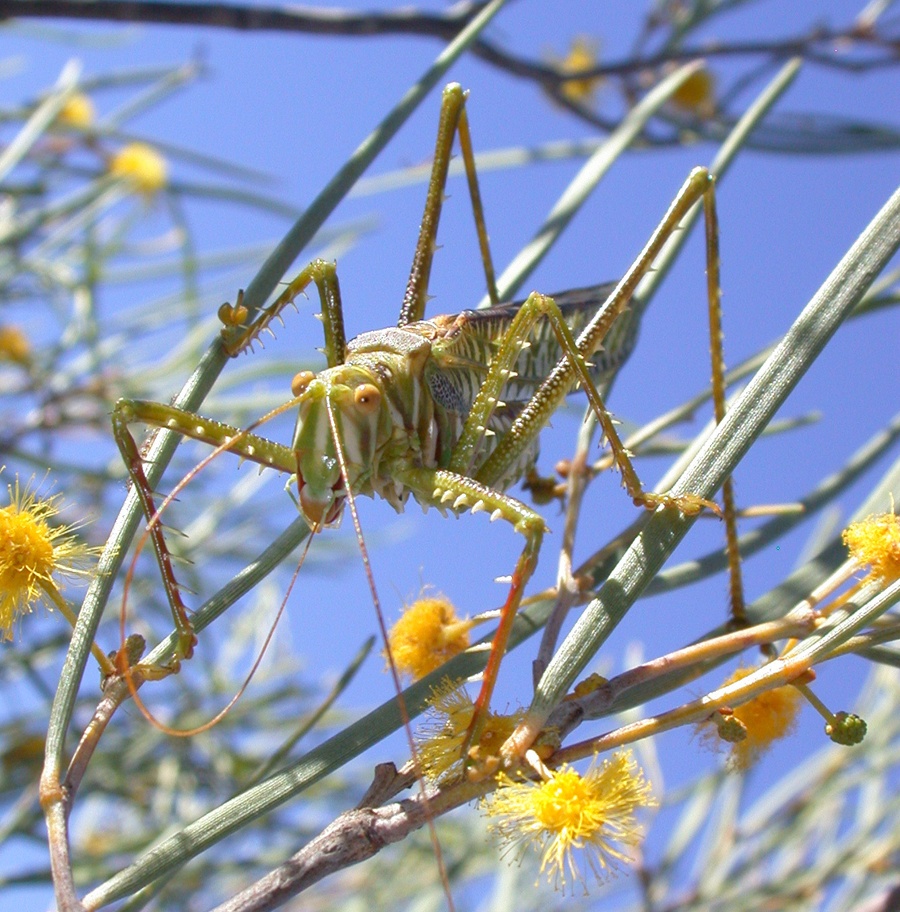Chlorobalius on:
[Wikipedia]
[Google]
[Amazon]
''Chlorobalius'' is a species of long-horned
 ''Chlorobalius leucoviridis'' is native to arid, inland regions of Australia. It is typically found high in a large bush or small tree.
''Chlorobalius leucoviridis'' is native to arid, inland regions of Australia. It is typically found high in a large bush or small tree.
grasshopper
Grasshoppers are a group of insects belonging to the suborder Caelifera. They are among what is possibly the most ancient living group of chewing herbivorous insects, dating back to the early Triassic around 250 million years ago.
Grasshopp ...
in the family Tettigoniidae containing the only species, ''Chlorobalius leucoviridis'', commonly known as the spotted predatory katydid. It is a predator and is an acoustic aggressive mimic of cicadas; by imitating the sounds and movements made by female cicadas, it lures male cicadas to within its reach and then eats them.
Taxonomy
''Chlorobalius leucoviridis'' was first described by the Prussian/Australian botanist andentomologist
Entomology () is the scientific study of insects, a branch of zoology. In the past the term "insect" was less specific, and historically the definition of entomology would also include the study of animals in other arthropod groups, such as arach ...
Johann Gottlieb Otto Tepper
Johann Gottlieb Otto Tepper (19 April 1841 – 16 February 1923) was a Prussian-born botanist, teacher, plant collector and entomologist who spent most of his life living and working in Australia. He spent much of his career with the South Austra ...
in 1896. It forms part of the family Tettigoniidae, the subfamily Listroscelidinae and the tribe Terpendrini, the gum-leaf katyatids.
Description
The adult ''Chlorobalius leucoviridis'' is a large, cryptically-coloured, long-horned grasshopper. The body, wings and legs are barred and spotted in green and white. The legs bear short spines and both males and females have stridulatory organs, the male has a file-and-scraper structure on thetegmen
A tegmen (plural: ''tegmina'') designates the modified leathery front wing on an insect particularly in the orders Dermaptera (earwigs), Orthoptera (grasshoppers, crickets and similar families), Mantodea (praying mantis), Phasmatodea (stick and ...
(fore-wing) while the female has pegs on the hind wing which rub against certain veins on the fore-wing.
Distribution and habitat
 ''Chlorobalius leucoviridis'' is native to arid, inland regions of Australia. It is typically found high in a large bush or small tree.
''Chlorobalius leucoviridis'' is native to arid, inland regions of Australia. It is typically found high in a large bush or small tree.
Behaviour
''Chlorobalius leucoviridis'' is nocturnal and occurs in small groups which move from one location to another. It feeds by catching other insects such as flies,grasshopper
Grasshoppers are a group of insects belonging to the suborder Caelifera. They are among what is possibly the most ancient living group of chewing herbivorous insects, dating back to the early Triassic around 250 million years ago.
Grasshopp ...
s and other katydid
Insects in the family Tettigoniidae are commonly called katydids (especially in North America), or bush crickets. They have previously been known as "long-horned grasshoppers". More than 8,000 species are known. Part of the suborder Ensifera, t ...
s, grasping the prey with its fore-legs or first two pairs of legs, and immobilising it by biting it under the throat. The spines on the legs seem to play a part in controlling larger prey items. The male makes loud, trilling songs to lead females of its own species towards its location.
The male attracts male cicadas on which to feed by mimicry, luring them to its vicinity by deception. This is accomplished both acoustically, by audible wing-clicking in a pattern similar to that used by sexually-receptive female cicadas, and visually by the use of synchronised body movements similar to those exhibited by the females. Remarkably, the katydid has the ability to mimic the sounds and movements of a number of different prey species, even some species with which it has never had direct contact.
References
{{Taxonbar, from1=Q14625415, from2=Q10450480 Taxa described in 1896 Tettigoniidae